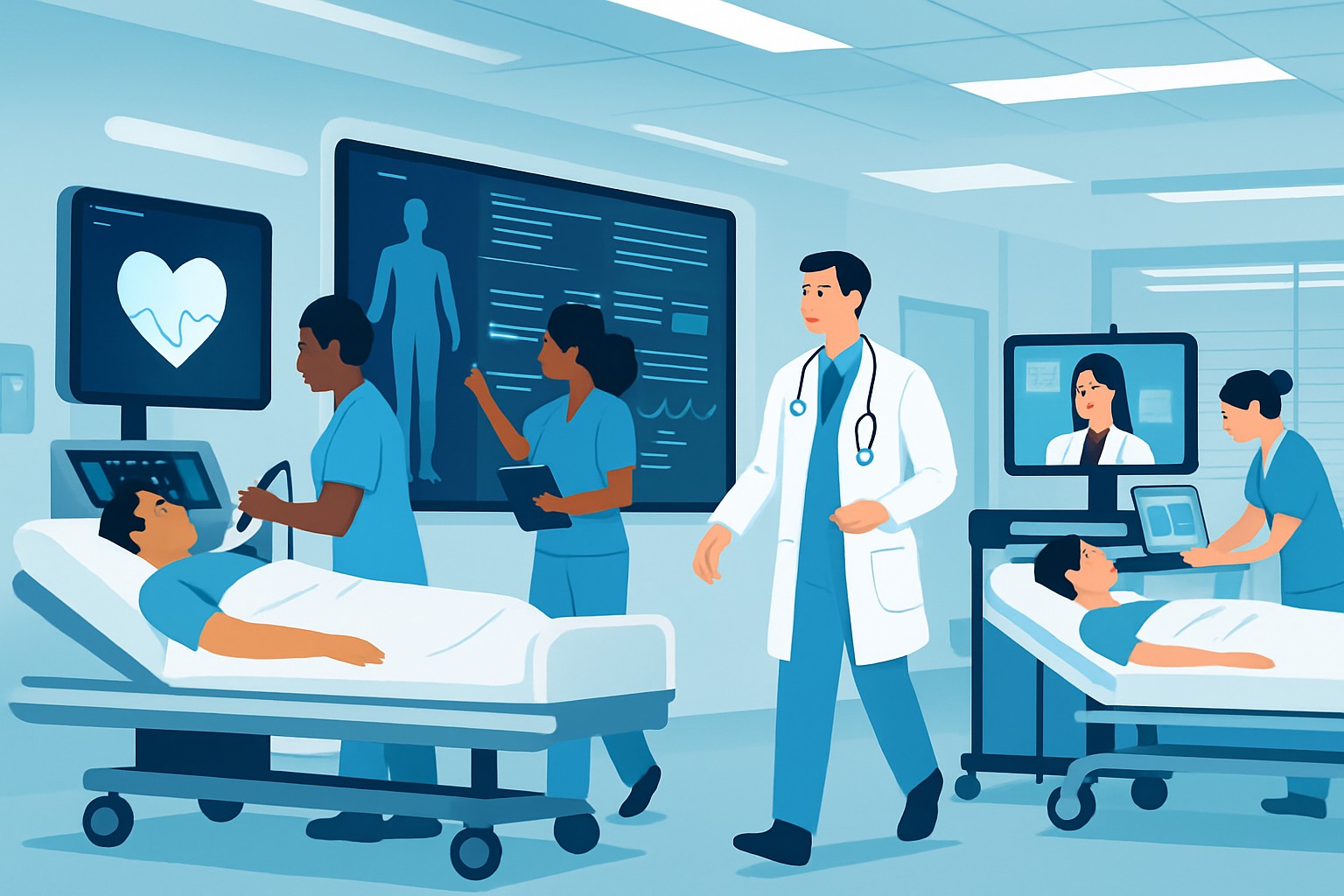
Is Emergency Medicine a Dying Field or Evolving?


Emergency medicine plays an essential role in quickly assessing and treating sudden illnesses and injuries, but many are now asking: is emergency medicine a dying field? Emergency doctors operate in fast-moving environments where they often face life-or-death situations that demand split-second decisions. There’s been some buzz about whether emergency medicine is slowly fading away because of doctor burnout, shifts in healthcare systems and changing patient needs.
Taking a Closer Look at the Nuts and Bolts of Emergency Medicine
Emergency medicine is a specialty focused on caring for patients who need urgent attention and often steps in when things take a sudden serious turn. Emergency physicians handle a broad spectrum of situations from everyday bumps and bruises to life-or-death moments like severe trauma, cardiac arrest and acute infections.
- Quickly sizing up patients to get a feel for how serious their condition might be and figure out who needs treatment first—kind of like triage but with a bit of gut instinct thrown in.
- Providing trauma care by stabilizing major injuries and broken bones to make sure the worst doesn’t spiral out of control.
- Tackling urgent medical issues such as heart attacks, strokes and infections head-on because there’s no time to waste in these high-stakes moments.
- Teaming up closely with specialists to coordinate advanced care and hospital admissions and smoothing out the handoff so nothing falls through the cracks.
- Carrying out lifesaving procedures like intubations, resuscitations and emergency surgeries when the situation demands it—rolling up sleeves and getting down to business.
Why Do Some Believe Emergency Medicine Is Running Into Challenges: Is Emergency Medicine a Dying Field?
There are a handful of key reasons why emergency medicine sometimes feels like a specialty running on fumes. High rates of physician burnout and a nonstop influx of patients combine with staffing shortages and relentless pressures within the healthcare system. This often leaves individuals questioning what lies ahead for emergency departments.
- Stressful work environments that all too often lead to quick emotional and physical burnout, leaving many feeling drained before the day is done.
- A noticeable rise in patient numbers, with many facing complex or long-term health conditions that require extra care and attention.
- Staff shortages that stretch the remaining team thin, resulting in longer shifts and less coverage than anyone would like.
- Financial challenges brought on by shifting reimbursement models and the ever-tight hospital budgets that seem to leave little wiggle room.
- An ever-growing pile of administrative tasks that eat into precious time better spent on actual clinical care, much to the frustration of healthcare workers.
"The relentless pressure and emotional toll have many seasoned emergency physicians pausing to reconsider their career paths. Honestly, without a stronger safety net of support, sticking with this grind over the long haul feels like a steep uphill climb." — Dr. Alicia Hayes, Emergency Medicine Specialist
How Emergency Medicine Is Changing and Growing with New Developments and Future Trends
Emergency medicine keeps evolving despite many hurdles. It eagerly embraces new technologies and updated clinical protocols along with system-wide reforms. These changes are not just for show — they are meant to improve patient care, increase efficiency and lighten the load on providers.
- Integrating telemedicine to offer remote consultations and triage easing overcrowding issues.
- Using artificial intelligence tools to help with patient triage and boost diagnostic accuracy because sometimes a second set of virtual eyes really helps.
- Strengthening collaboration among multidisciplinary teams including nurses, specialists and social workers to ensure everyone is pulling together like a well-oiled machine.
- Expanding roles to tackle public health emergencies such as pandemics and mass casualty events, stepping up when it really counts.
- Implementing advanced trauma systems designed to improve patient outcomes and juggle resources more smoothly, which is no small feat.
Emergency departments are shaking up their workflows to better weave in the latest technologies and smooth out the patient journey through the system. Training programs are stepping up their game too, putting more emphasis on digital health tools and teamwork.
| Aspect | Traditional Emergency Medicine | Evolving Emergency Medicine |
|---|---|---|
| Patient Intake | Face-to-face triage and initial assessment | A blend of telemedicine and AI-supported triage, making the first step feel a bit less like waiting in line and more like a chat with a tech-savvy helper |
| Diagnostic Tools | Decisions made manually using standard tests | AI-powered diagnostics teaming up with portable devices, kind of like having a detective and their trusty sidekick on hand |
| Care Coordination | Referrals to specialists following assessment | Multidisciplinary teams working hand in hand with much speedier coordination — no more passing the baton in slow motion |
| Physician Role | Making decisions alone under pressure | Leading collaboratively with digital health tools, juggling expertise with a touch of tech support |
| Handling Public Emergencies | Reactive and improvised responses | Taking proactive roles in public health planning and action, stepping up before the storm hits |
This comparison highlights perks like smoother efficiency and stronger teamwork, while also nudging us to remember the hurdles like ongoing training needs and embracing new technology.

Visual depiction of a modern emergency department incorporating new technologies and team dynamics.
Common Misunderstandings About the Future of Emergency Medicine Clearing Up the Fog
There are quite a few myths swirling around that cloud the true picture of emergency medicine. People often get carried away overestimating what automation can actually achieve, while undervaluing how flexible and quick on its feet this field really is.
- The idea that AI and automation will completely replace emergency physicians is often exaggerated because human judgment still plays a vital role.
- Emergency medicine isn’t disappearing; in fact it’s growing as healthcare needs change.
- Burnout remains a challenge but with system improvements and stronger support networks it is being managed and does not mean the field is declining.
- There are exciting opportunities for career growth in leadership, research and education making emergency medicine a field full of potential.
- Emergency medicine involves much more than managing immediate crises. It also includes preventive public health and managing chronic conditions.
A Closer Look
Recent data suggests that emergency medicine is grappling with some pretty tough workforce challenges, like soaring patient numbers alongside a shrinking pool of physicians. Survival rates for serious emergencies appear to be on the upswing, thanks to smarter treatment methods and clever technology. Wait times can be a bit of a mixed bag, but hospitals experimenting with fresh care models often report smoother patient flow and happier patients overall.
| Metric | 2013 | 2023 | Percentage Change |
|---|---|---|---|
| Emergency Medicine Physicians | 38,000 | 42,500 | +11.8% |
| Average Patient Wait Time (min) | 45 | 38 | -15.6% |
| Annual Patient Visits (millions) | 130 | 150 | +15.4% |
| Survival Rate after Cardiac Arrest | 22% | 30% | +36.4% |
| Physician Burnout Rate | 42% | 48% | +14.3% |
This table clearly highlights some good news: more emergency medicine physicians are on the scene and patient outcomes have taken a noticeable turn for the better. That said, the persistent rise in physician burnout is a bit of a red flag—definitely something we cannot afford to overlook.
The data lays bare not just the heavy strain emergency departments are under, but also their impressive knack for adapting on the fly. Rising staffing numbers alongside better survival rates hint at genuine progress, though the stubborn persistence of burnout reminds us that some tough challenges are far from over.
Getting Ready for What Comes Next How Emergency Medicine Professionals Are Stepping Up and Shifting Gears
Given these dynamic shifts, a common question arises: is emergency medicine a dying field? The answer is a definitive no, as its professionals are steadily broadening their skill sets to embrace new technologies and foster a spirit of teamwork while making mental health a top priority.
- Getting comfortable with technology is key to really unlocking the potential of AI tools and telemedicine platforms. It pays off when things click.
- Fostering teamwork across different specialties not only lifts patient care but also lightens the often overwhelming load on providers.
- Spreading the word and backing initiatives that champion mental health and physician well-being has become more important than ever.
- Taking the lead during public health emergencies while advocating for stronger emergency care policies shows real commitment when it counts the most.
- Staying curious and dedicated to ongoing learning helps keep pace with ever-shifting clinical guidelines and the latest advances in healthcare.
"Getting emergency physicians ready to take the lead in clinical care and health innovation is absolutely important for keeping our specialty sharp and prepared to tackle whatever future healthcare challenges throw our way." — Dr. Michael Tran, Medical Educator





